This website is supported by its readers. If you click one of my links I may earn a commission. I am also a participant in the Amazon affiliates program and I will also earn a commission from qualified purchases.
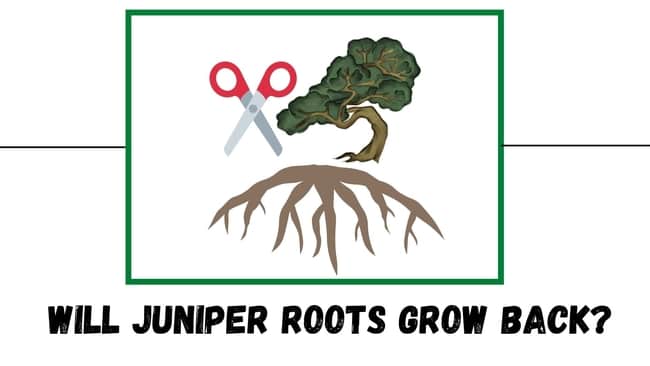
Juniper trees come in over 60 different sub-species and are easily one of the most popular house and garden plants many of us own. That being said, some species of Juniper can have extensive root balls and roots that can damage surrounding areas. A common question many of us have is, will Juniper roots grow back if removed?
Evergreen bushes like Junipers cannot survive without their roots or branches. Juniper roots will not grow back if removed correctly with the stump and branches. The exception is if excessive branches with leaves grow on the stump/branches, which can cause some roots to recover.
So why is it essential to remove Juniper roots? And what are the quick steps you can follow to remove your Juniper roots/ sump? Keep reading to find out more!
Just a quick heads up, over the past three years of running Plantpaladin, hundreds of people have asked for product recommendations. As such, You can find my favorite indoor bonsai tree here (link takes you to Bonsaiboy), my favorite outdoor bonsai tree (link takes you to Bonsaiboy), or have a look at all the products I recommend here.
Will Juniper roots grow back?
As many of you know, I recently moved homes and now have the luxury of a relatively large garden/back yard.
Luckily, the previous owners left an 8-foot-tall Irish Juniper near my neighbor’s fence.
While this tree adds to the garden, there are pros and cons to the tree.
As it is close to the boundary between my house and my neighbors, I have always wondered if I need to move the tree or trim its roots, will its roots grow back?
As such, I got in touch with a few experts, visited my local botanical gardens, and even surveyed ten Plant Paladin readers to understand and answer the question of whether Junipers grow back.
Ensuring you have the most in-depth post covering this on the web.
To summarize then:
- Juniper tree roots will typically not grow back if cut back or removed.
- This is provided the roots and stump have been dug up, and there are no leaves or new growth in or around the tree.
- If you find some new growth/leaves near the roots, then photosynthesis will occur, causing the tree’s roots to grow back and new growth to appear on the tree overall.
- If you need to remove your Juniper roots, do so in stages, trimming back the branches, removing the stump, and finally digging up, cutting back, detangling, and removing the roots from the tree.
- You will typically remove juniper roots for a few reasons, including damage to local amenities such as pipes, guttering, or sewage.
- Juniper roots can also absorb nutrients from their soil which can impact the health of surrounding trees.
How to remove Juniper roots?
So now that we know that most Juniper species will not grow back if we remove their roots correctly, what is the exact step-by-step process of removing Juniper roots.
Before we remove the roots of a Juniper tree, we must focus on extracting and killing the rest of the tree first.
As mentioned, if you remove or trim the Juniper roots without removing the branches, trunk, or sump first, then there is a good chance your roots will grow back excessively, and your tree will thrive again.
On top of this, even if you trim back your Juniper tree to a stump, but the stump still has a few branches with the tip/needle-like leaves that Junipers have, there is a good chance that this too can rejuvenate a Juniper tree.
Remove Juniper branches
To remove Juniper branches, get a sharp pair of scissors or gardening shears and trim back the branches of your Juniper at a 45-degree angle until the tree trunk is left.
Aim to do this during the summer when there will be less sap in Juniper trees.
Then gather all the branches and dispose of them in your garden waste disposal center.
Create a stump
Now that you have a giant trunk without any branches, it is time to convert this to a stump.
To do so, make three cuts on your Juniper tree and eye level, one horizontal, one at a 45-degree angle, and one at the opposite side.
Repeat this process until you have a small stump only a few inches above ground level.
Water the ground
Now you have a stump; it is time to remove it.
Prepare the area by watering the ground around the stump to saturate the soil.
Watering the soil will make the stump easier to lift and remove.
Remove the stump
You can now pry away your stump easily from the ground.
To do so, use a shovel.
Dig the shovel at a 45-degree angle until you hit the bottom of the stump and lift it out.
You will take a few attempts.
Do not worry about removing the roots in the first instance; try to get rid of the stump.
Aim to get the stump as high above the ground as possible.
Remove the roots connected to the stump
At this stage, you will have a stump that is probably half hanging out of the ground, half underground, with the roots holding on to the stump, making it difficult to remove.
If this is the case, use pruning shears or similar tools to cut the roots from the stump one by one until you can remove the stump without it being held back by roots.
Move your stump to garden waste at this stage.
Remove the underground roots
While the roots on the stump are removed, some Juniper roots can be 25 feet deep.
Removing the excessive roots and the root ball from the ground will be vital.
To do so, dig as deep as you can into your soil, and untangle and pull out as many roots as you can by hand and using shears.
The big aim here is to remove the root ball/taproot, which is the heart of all the roots. Try to cut around the root ball, and you should find removing the remaining roots a lot easier.
Remove any seedling near the roots
If you have a very excessive root structure, try as you might; you might not be able to get to the deep roots.
Thankfully, using the methods above, your roots will not grow back.
The only exception is if you find seedlings in and around the Juniper tree near your roots on the topsoil where you removed the stump.
If this is the case, remove these seedlings as quickly as you can see them.
Trim the seedling to just below the soil line and pull the roots out.
They should remove themselves from any other soil or root structure.
Other methods to kill Juniper roots
While the above method is the best method for removing roots, you can also use chemical herbicides (link takes you to Amazon) or use a copper nail/screw and drill this in the stump of your tree to kill the roots.
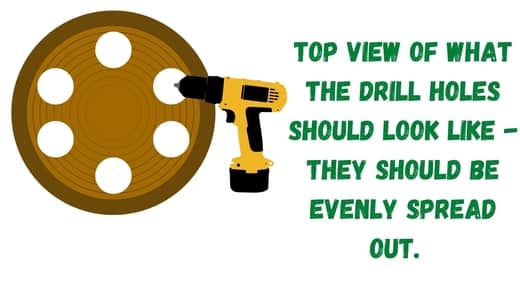
These methods can impact the surrounding tree, so be careful if utilizing these methods.
Removing partial Juniper roots
So now you know if Juniper roots grow back and how to remove Juniper roots. What if you need to trim back your Juniper roots without damaging the rest of your tree?
After all, many of you are reading this with excessive roots but don’t want to kill your tree.
The main scenario for this will be if you keep your Juniper in a pot and need to repot your tree when the roots outgrow the pot.
Luckily, this too can be done.
Use a root hook to pry your Juniper loose around the edge of your pot.
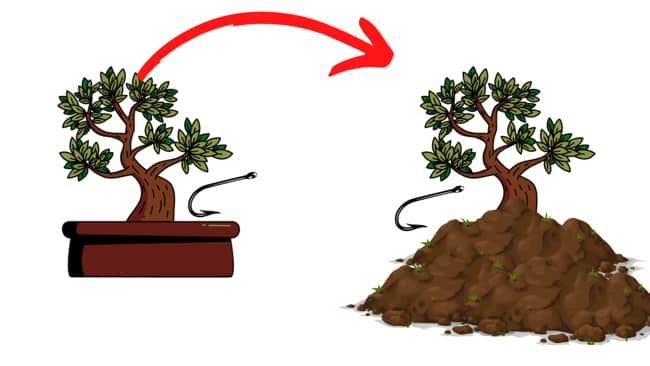
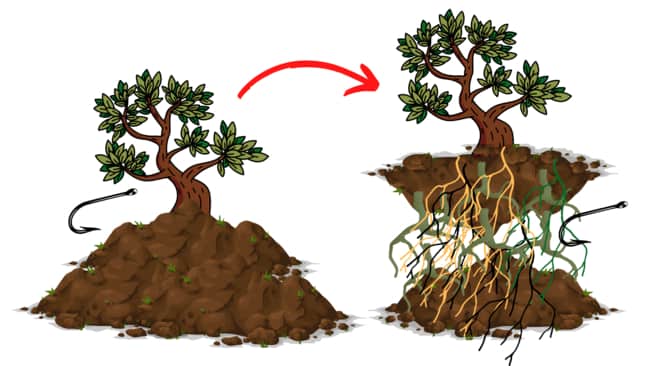
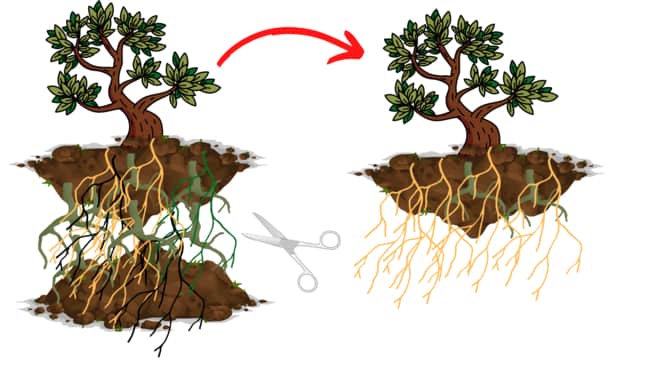
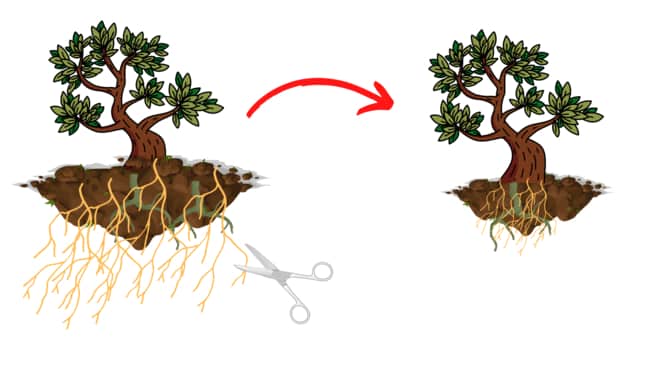
Then lift the Juniper and its roots and trim any excessive roots – including feeder roots.
Aim to keep the root ball structure intact if you can.
Then repot your tree like you would any other tree.
To read up more on this process, check out my post on repotting trees here.
How deep do Juniper roots go?
Juniper tap roots typically fall 25 feet deep when fully grown or about the same depth as the tree’s height. Lateral roots in Juniper can grow as deep as 100 feet. Juniper species such as Creeping Juniper will grow their roots the deepest.
Why is it important to know if Juniper roots grow back?
It’s important to know if Juniper roots grow back for a few reasons.
First, Juniper roots, regardless of species, can be incredibly flammable.
If then your tree roots become burnt, knowing if you can salvage your tree or not will be vital.
Secondly, Juniper roots, especially in species like creeping Juniper, which is Moore fast-growing, can be incredibly invasive.
With the roots from fully grown trees stretching as deep as 25 feet in some situations, these roots can disrupt and unearth pipes, bricks, concrete, and other items.
As such, if you plant Juniper too close to your home or any residential items (such as my neighbor’s fence), you need to keep in mind that you will need to unearth and repot your Juniper.
Another challenge with Juniper is that the roots tend to absorb all the nutrients from the soil.
This soil absorption leaves a limited amount of the rest of your tree in your collection.
If you keep your Juniper in the ground, your other trees in the same soil may also suffer.
Finally, Junipers are relatively straightforward to propagate, meaning if you fail to remove the roots of your Juniper correctly, the roots can still sprout seedlings causing new Juniper trees to grow.
Which Juniper roots are the most invasive?
Juniper roots from Common Juniper, Creeping Juniper, and Redberry Juniper are among the most invasive. The taproot from these trees can grow 25 feet deep, with feeder roots growing over 100 feet deep.
Will Juniper roots grow back – Study
As mentioned, I visited my local botanical gardens and asked them if Juniper roots grow back – here is what one of the employees there said to me:
“If the tree stump has been removed, most Juniper trees won’t grow back provided all the foliage has been removed.”
I also asked ten plant paladin readers who own Junipers if their Juniper roots grow back after they removed them in different scenarios – you can see the results below:
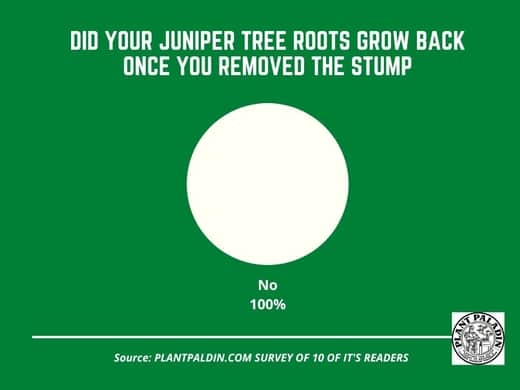
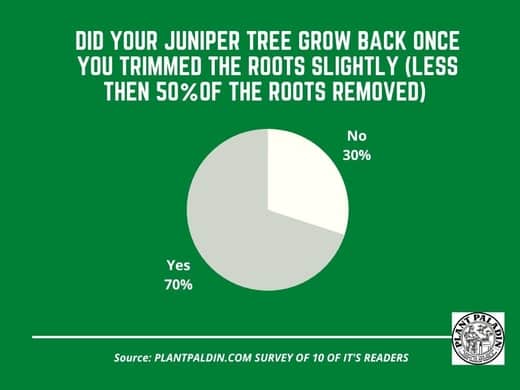
How to take care of a Juniper tree?
Many of you are also in the process of buying or growing Juniper.
If this is the case, check out the table below, which goes into more detail on how to grow Juniper:
Apple bonsai tree requirements | Explained |
Water | 3 times per week in the spring and summer. Once to twice per week in the winter. |
Sunlight | 4 hours of direct sunlight per day. |
Temperature | 14 to 85 degrees Fahrenheit |
Fertilizer | once per month in the spring and summer - avoid in fall and winter. |
Repotting | Once every 2 to 3 years |
Placement | Outdoors only |
Species Type | Coniferous |
Wire type | Both copper and aluminum |
Time to grow from seed | 3 years |
Potting Soil | Inorganic mix of akadama and volcanic ash rock. Organic soil such as peat soil can also be used. |
Growth type | Medium growth - adds 5 to 12 inches per year in height. |
Size | Medium to large, most trees sold is typically two hand bonsai. |
Lifespan | 500 years + |
I also recommend checking out the following posts on Juniper trees:
- How much do Juniper berries weigh?
- Can Juniper bonsai survive winter?
- Is Juniper toxic to Cats?
- Juniper bonsai temperature range
My top picks for the gear you will need!
So like I mentioned earlier, over the past three years of running PlantPaladin, hundreds of people have asked me for my recommendations on the best bonsai gear on the market.
Having spent thousands of dollars on bonsai items these past few years and tested at least 100 bonsai-specific products, I’ve listed my favorite products below – All of which I highly recommend and think you can get great value.
They can purchase directly by clicking the link to take them to Amazon.
Bonsai Tool Set: One of the significant challenges I’ve had is finding a toolset that was not only durable but didn’t break the bank. SOLIGT has recently developed a fantastic bonsai tool set that covers all the tools you need to trim, prune, and repot your trees. – You can grab it here.
Complete Bonsai Set: Many of you will want to grow your bonsai trees entirely from scratch, but finding the varicose seeds, pots, and other items in one place can be challenging. Leaves and Sole then have created a complete bonsai set that I’ve personally used that ticks all the boxes. You can grab it here.
Bonsai wire: The number of times I’ve run out of wire for my bonsai or purchased cheap bonsai wire that doesn’t do the job is embarrassing for me to admit. After a lot of trial and error, I found that using Hotop’s aluminum bonsai wire is one of the best options on the market. This can easily be used for both indoor and outdoor bonsai. You can grab it here.
This post was written by Fehed Nicass who has been passionate about bonsai for over 3 years. He currently resides in the UK and works in sales

